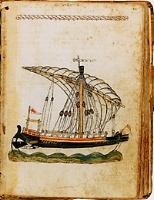A new trilogy and web site about 15th-century mariner Michael of Rhodes will result from a $425,000 grant to the Dibner Institute for the History of Science and Technology at MIT.
The money from the National Science Foundation and the National Endowment for the Humanities will fund a research project centered on a 420-page scientific and technological manuscript about Michael of Rhodes, who traveled to Venice in 1401 to join the Navy and served for 42 years.
Michael, who began his career as an oarsman, was promoted to chief oarsman, steersman, boatswain, adviser, captain of a small galley, mate and finally captain of a vessel. In addition to serving in the guard fleet, whose main duty was to protect Venice, he went on numerous trading voyages to Flanders, London (in 1406, 1438 and 1443), Alexandria, the Crimea, Trebizond and Aigues Mortes. He also was involved in historic sea battles: a victory over the Turks in 1416 at Gallipoli, and two others in 1424 and 1431.
In 1434 he began a written record of his knowledge and experiences. The result is a unique compendium of the scientific and technical knowledge of a common man of the 15th century, containing more than 160 pages of practical mathematics, the first known European treatise on shipbuilding, rare navigational aids, astronomical tables, illustrated astrological materials and an unusual year-by-year account of Michael's voyages. The manuscript also contains prayers against fevers and serpents, for catching fish, and for stopping a nosebleed.
The manuscript's existence was not widely known until 1966, when it was sold at Sotheby's. Then it disappeared again. When it reappeared and was auctioned in 2000, its new owner made the text available exclusively to the Dibner Institute for historical study.
The Dibner Institute has put together an international team of research specialists who plan to produce a three-volume publication, which will include a facsimile of the original manuscript, a transcription, an English translation, and a series of brief historical studies of the scientific and technological material contained in the text.
The team is headed by independent scholars Alan Stahl, an expert in Venetian history and documents, and Pamela Long, a noted historian of Renaissance technology. David McGee, a research associate at the Dibner Institute's Burndy Library, is the project coordinator.
The web site, aimed at middle school and high school students and teachers, will be created in collaboration with WGBH Interactive.
Users can choose from one of Michael's voyages with the site's interactive "journey map." They can learn about navigation routes, ships and goods traded, as well as the structure and solution of typical mathematical topics discussed in the manuscript, the Hindu place value system, the value of Arabic numerals and the reasoning behind such mathematical practices as the "rule of three."
A version of this article appeared in MIT Tech Talk on October 29, 2003.






